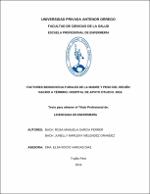Mostrar el registro sencillo del ítem
Factores biosocioculturales de la madre y peso del recién nacido a término. Hospital de Apoyo Otuzco. 2016
| dc.contributor.advisor | Vargas Diaz, Elsa Rocio | |
| dc.contributor.author | Garcia Ferrer, Rosa Manuela | |
| dc.contributor.author | Melendez Grandez, Junelly Marleny | |
| dc.creator | Garcia Ferrer, Rosa Manuela | |
| dc.date.accessioned | 2017-06-05T22:15:03Z | |
| dc.date.available | 2017-06-05T22:15:03Z | |
| dc.date.issued | 2017 | |
| dc.identifier.uri | https://hdl.handle.net/20.500.12759/2751 | |
| dc.description.abstract | El objetivo de este estudio es determinar la relación entre los factores biosocioculturales de la madre y peso del recién nacido a término. Hospital de Apoyo Otuzco.2016. La presente investigación es de tipo prospectivo correlacional y de corte transversal. La población en estudio estuvo conformada por 40 madres de recién nacidos a término. Se aplicó un instrumento creado por Rubio y Salazar (2012), modificado por las autoras para identificar los factores biosocioculturales de la madre y peso del recién nacido a término. Se encontró que el 75% de recién nacidos presentan peso adecuado del cual el mayor porcentaje de madres en un 33% se encuentran entre 25-29 años y el 35% son multíparas. El 15% de recién nacidos a término tienen peso bajo al nacer del cual el 13% son madres menores de 20 años y el 8% son primíparas. Aplicada a la prueba estadística Gamma (valor-p<0.05), los factores que se relacionan con el peso del recién nacido a término son la edad y paridad. | es_PE |
| dc.description.abstract | The objective in this study is to determine the relationship between the biosociocultural factors of the mother and weight of the newborn to term.Otuzco support hospital.2016. This research correlational prospective and cross- sectional. The study population consisted of 40 mothers of newborns to term. An instrument was applied created by Rubio y Salazar (2012), modified by the authors to identify the biosociocultural factors of the mother and weight of the newborn to term. It was found that 75% of newborns presented adequate weight of which the largest percentage of mothers in a 33% to find between 25- 29 years and 35% are multiparous. That 15% of the newborn to term to have low weight of which 13% are mothers smaller of twenty years and 8% are primiparity. It applied to statistical Gamma test (p-value <0.05), that factors that relate to the newborn weight at term are age and parity. | en_US |
| dc.description.uri | Tesis | es_PE |
| dc.format | application/pdf | es_PE |
| dc.language.iso | spa | es_PE |
| dc.publisher | Universidad Privada Antenor Orrego | es_PE |
| dc.relation.ispartofseries | T_ENFE_376 | |
| dc.rights | info:eu-repo/semantics/openAccess | es_PE |
| dc.rights.uri | https://creativecommons.org/licenses/by/4.0/ | es_PE |
| dc.source | Universidad Privada Antenor Orrego | es_PE |
| dc.source | Repositorio Institucional - UPAO | es_PE |
| dc.subject | Factores biosocioculturales de la madre | es_PE |
| dc.subject | Peso del recién nacido | es_PE |
| dc.title | Factores biosocioculturales de la madre y peso del recién nacido a término. Hospital de Apoyo Otuzco. 2016 | es_PE |
| dc.type | info:eu-repo/semantics/bachelorThesis | es_PE |
| thesis.degree.level | Título Profesional | es_PE |
| thesis.degree.grantor | Universidad Privada Antenor Orrego. Facultad de Ciencias de la Salud | es_PE |
| thesis.degree.name | Licenciada en Enfermería | es_PE |
| thesis.degree.discipline | Enfermería | es_PE |
| renati.type | https://purl.org/pe-repo/renati/type#tesis | es_PE |
| renati.level | https://purl.org/pe-repo/renati/level#tituloProfesional | es_PE |
| dc.publisher.country | PE | es_PE |
Ficheros en el ítem
Este ítem aparece en la(s) siguiente(s) colección(es)
-
Enfermería [273]


